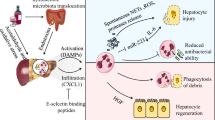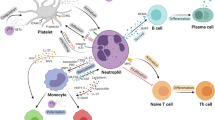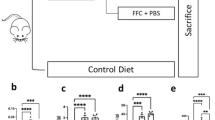Abstract
Liver disease encompasses a wide variety of liver conditions, including liver failure, liver cirrhosis and a spectrum of acute and chronic hepatitis, such as alcoholic, fatty, drug, viral and chronic hepatitis. Liver injury is a primary causative factor in liver disease; generally, these factors include direct liver damage and immune-mediated liver injury. Neutrophils (also known as neutrophilic granulocytes or polymorphonuclear leukocytes (PMNs)) are the most abundant circulating white blood cell type in humans, and PMNs are a major innate immune cell subset. Inappropriate activation and homing of neutrophils to the microvasculature contributes to the pathological manifestations of many types of liver disease. This review summarizes novel concepts of neutrophil-mediated liver injury that are based on current clinical and animal model studies.
This is a preview of subscription content, access via your institution
Access options
Subscribe to this journal
Receive 12 digital issues and online access to articles
$119.00 per year
only $9.92 per issue
Buy this article
- Purchase on Springer Link
- Instant access to full article PDF
Prices may be subject to local taxes which are calculated during checkout



Similar content being viewed by others
References
Kubes P, Mehal WZ . Sterile inflammation in the liver. Gastroenterology 2012; 143: 1158–1172.
Cheretakis C, Leung R, Sun CX, Dror Y, Glogauer M . Timing of neutrophil tissue repopulation predicts restoration of innate immune protection in amurine bone marrow transplantation model. Blood 2006; 108: 2821–2826.
Ulich TR, del Castillo J, Souza L . Kinetics and mechanisms of recombinant human granulocyte-colony stimulating factor-induced neutrophilia. Am J Pathol 1988; 133: 630–638.
McDonald B, McAvoy EF, Lam F, Gill V, de la Motte C, Savani RC et al. Interaction of CD44 and hyaluronan is the dominant mechanism for neutrophil sequestration in inflamed liversinusoids. J Exp Med 2008; 205: 915–927.
Nathan C . Neutrophils and immunity: challenges and opportunities. Nat Rev Immunol 2006; 6: 173–182.
Bajt ML, Farhood A, Jaeschke H . Effects of CXC chemokines on neutrophil activation and sequestration in hepatic vasculature. Am J Physiol Gastrointest Liver Physiol 2001; 281: 1188–1195.
Guo RF, Ward PA . Mediators and regulation of neutrophil accumulation in inflammatory responses in lung: insights from the IgG immune complex model. Free Radic Biol Med 2002; 33: 303–310.
Pillay J, Kamp VM, van Hoffen E, Visser T, Tak T, Lammers JW et al. A subset of neutrophils in human systemic inflammation inhibits T cell responses through Mac-1. J Clin Invest 2012; 122: 327–336.
Puga I, Cols M, Barra CM, He B, Cassis L, Gentile M et al. B cell-helper neutrophils stimulate the diversification and production of immunoglobulin in the marginal zone of the spleen. Nat Immunol 2011; 13: 170–180.
Jaeger BN, Donadieu J, Cognet C, Bernat C, Ordoñez-Rueda D, Barlogis V et al. Neutrophil depletion impairs natural killer cell maturation, function, and homeostasis. J Exp Med 2012; 209: 565–580.
El Kebir D, Filep JG . Modulation of neutrophil apoptosis and the resolution of inflammation through β2 integrins. Front Immunol 2013; 4: 60.
Selzner N, Rudiger H, Graf R, Clavien PA . Protective strategies against ischemic injury of the liver. Gastroenterology 2003; 125: 917–936.
Ramaiah SK, Jaeschke H . Role of neutrophils in the pathogenesis of acute inflammatory liver injury. Toxicol Pathol 2007; 35: 757–766.
Cerqueira NF, Hussni CA, Yoshida WB . Pathophysiology of mesenteric ischemia/reperfusion: a review. Acta Cir Bras 2005; 20: 336–343.
Jaeschke H, Farhood A . Neutrophil and Kupffer cell-induced oxidant stress and ischemia–reperfusion injury in rat liver. Am J Physiol 1991; 260: G355–G362.
Kono H, Fujii H, Ogiku M, Hosomura N, Amemiya H, Tsuchiya M et al. Role of IL-17A in neutrophil recruitment and hepatic injury after warm ischemia–reperfusion mice. J Immunol 2011; 187: 4818–4825.
Tan Z, Jiang R, Wang X, Wang Y, Lu L, Liu Q et al. RORγt+IL-17+ neutrophils play a critical role in hepatic ischemia–reperfusion injury. J Mol Cell Biol 2013; 5: 143–146.
Abu-Amara M, Yang SY, Tapuria N, Fuller B, Davidson B, Seifalian A . Liver ischemia/reperfusion injury: processes in inflammatory networks—a review. Liver Transpl 2010; 16: 1016–1032.
Kim MS, Lee KH, Lee WM, Jun JH, Kim DH . CD44 disruption attenuates murine hepatic ischemia/reperfusion injury. J Korean Med Sci 2011; 26: 919–926.
Uchida Y, Freitas MC, Zhao D, Busuttil RW, Kupiec-Weglinski JW . The protective function of neutrophil elastase inhibitor in liver ischemia/reperfusion injury. Transplantation 2010; 89: 1050–1056.
Datta G, Fuller BJ, Davidson BR . Molecular mechanisms of liver ischemia reperfusion injury: insights from transgenic knockout models. World J Gastroenterol 2013; 19: 1683–1698.
Harlan JM, Winn RK . Leukocyte–endothelial interactions: clinical trials of anti-adhesion therapy. Crit Care Med 2002; 30: S214–S219.
Takai S, Kimura K, Nagaki M, Satake S, Kakimi K, Moriwaki H . Blockade of neutrophil elastase attenuates severe liver injury in hepatitis B transgenic mice. J Virol 2005; 79: 15142–15150.
Alvarez-Uria G, Day JN, Nasir AJ, Russell SK, Vilar FJ . Reduction in neutrophil count during hepatitis C treatment: drug toxicity or predictor of good response? Dig Dis Sci 2010; 55: 2058–2062.
Sitia G, Isogawa M, Kakimi K, Wieland SF, Chisari FV, Guidotti LG . Depletion of neutrophils blocks the recruitment of antigen-nonspecific cells into the liver without affecting the antiviral activity of hepatitis B virus-specific cytotoxic T lymphocytes. Proc Natl Acad Sci USA 2002; 99: 13717–13722.
Koo SH . Nonalcoholic fatty liver disease: molecular mechanisms for the hepatic steatosis. Clin Mol Hepatol 2013; 19: 210–215.
Rensen SS, Bieghs V, Xanthoulea S, Arfianti E, Bakker JA, Shiri-Sverdlov R et al. Neutrophil-derived myeloperoxidase aggravates non-alcoholic steatohepatitis in low-density lipoprotein receptor-deficient mice. PLoS ONE 2012; 7: e52411.
Larter CZ, Yeh MM, Haigh WG, van Rooyen DM, Brooling J, Heydet D et al. Dietary modification dampens liver inflammation and fibrosis in obesity-related fatty liver disease. Obesity 2013; 21: 1189–1199.
Inzaugarat ME, Ferreyra Solari NE, Billordo LA, Abecasis R, Gadano AC, Cherñavsky AC . Altered phenotype and functionality of circulating immune cells characterize adult patients with nonalcoholic steatohepatitis. J Clin Immunol 2011; 31: 1120–1130.
Ibusuki R, Uto H, Arima S, Mawatari S, Setoguchi Y, Iwashita Y et al. Transgenic expression of human neutrophil peptide-1 enhances hepatic fibrosis in mice fed a choline-deficient, L-amino acid-defined diet. Liver Int 2013; 33: 1547–1556.
Alkhouri N, Morris-Stiff G, Campbell C, Lopez R, Tamimi TA, Yerian L et al. Neutrophil to lymphocyte ratio: a new marker for predicting steatohepatitis and fibrosis in patients with nonalcoholic fatty liver disease. Liver Int 2012; 32: 297–302.
Gao B, Bataller R . Alcoholic liver disease: pathogenesis and new therapeutic targets. Gastroenterology 2011; 141: 1572–1585.
Taïeb J, Delarche C, Ethuin F, Selloum S, Poynard T, Gougerot-Pocidalo MA et al. Ethanol-induced inhibition of cytokine release and protein degranulation in human neutrophils. J Leukoc Biol 2002; 72: 1142–1147.
Woodfin A, Voisin MB, Nourshargh S . Recent developments and complexities in neutrophil transmigration. Curr Opin Hematol 2010; 17: 9–17
Kono H, Uesugi T, Froh M, Rusyn I, Bradford BU, Thurman RG . ICAM-1 is involved in the mechanism of alcohol-induced liver injury: studies with knockout mice. Am J Physiol Gastrointest Liver Physiol 2001; 280: G1289–G1295.
Bertola A, Park O, Gao B . Chronic plus binge ethanol feeding synergistically induces neutrophil infiltration and liver injury in mice: a critical role for E-selectin. Hepatology 2013; 58: 1814–1823.
Gao B, Seki E, Brenner DA, Friedman S, Cohen JI, Nagy L et al. Innate immunity in alcoholic liver disease. Am J Physiol Gastrointest Liver Physiol 2011; 300: G516–G525.
Fujimoto M, Uemura M, Nakatani Y, Tsujita S, Hoppo K, Tamagawa T et al. Plasma endotoxin and serum cytokine levels in patients with alcoholic hepatitis: relation to severity of liver disturbance. Alcohol Clin Exp Res 2000; 24: 48S–54S.
Degré D, Lemmers A, Gustot T, Ouziel R, Trépo E, Demetter P et al. Hepatic expression of CCL2 in alcoholic liver disease is associated with disease severity and neutrophil infiltrates. Clin Exp Immunol 2012; 169: 302–310.
Ziol M, Tepper M, Lohez M, Arcangeli G, Ganne N, Christidis C et al. Clinical and biological relevance of hepatocyte apoptosis in alcoholic hepatitis. J Hepatol 2001; 34: 254–260.
Biyik M, Ucar R, Solak Y, Gungor G, Polat I, Gaipov A et al. Blood neutrophil-to-lymphocyte ratio independently predicts survival in patients with liver cirrhosis. Eur J Gastroenterol Hepatol 2013; 25: 435–441.
Papp M, Sipeki N, Vitalis Z, Tornai T, Altorjay I, Tornai I et al. High prevalence of IgA class anti-neutrophil cytoplasmic antibodies (ANCA) is associated with increased risk of bacterial infection in patients with cirrhosis. J Hepatol 2013; 59: 457–466.
Gungor G, Ataseven H, Demir A, Solak Y, Gaipov A, Biyik M et al. Neutrophil gelatinase-associated lipocalin in prediction of mortality in patients with hepatorenal syndrome: a prospective observational study. Liver Int 2013; 34: 49–57.
Tritto G, Bechlis Z, Stadlbauer V, Davies N, Francés R, Shah N et al. Evidence of neutrophil functional defect despite inflammation in stable cirrhosis. J Hepatol 2011; 55: 574–581.
Mookerjee RP, Stadlbauer V, Lidder S, Wright GA, Hodges SJ, Davies NA et al. Neutrophil dysfunction in alcoholic hepatitis superimposed on cirrhosis is reversible and predicts the outcome. Hepatology 2007; 46: 831–840.
Jaeschke H, Williams CD, Ramachandran A, Bajt ML . Acetaminophen hepatotoxicity and repair: the role of sterile inflammation and innate immunity. Liver Int 2012; 32: 8–20.
Zou Z, Li B, Xu D, Zhang Z, Zhao JM, Zhou G et al. Imbalanced intrahepatic cytokine expression of interferon-gamma, tumor necrosis factoralpha, and interleukin-10 in patients with acuteon-chronic liver failure associated with hepatitis B virus infection. J Clin Gastroenterol 2009; 43: 182–190.
Antoniades CG, Berry PA, Wendon JA, Vergani D . The importance of immune dysfunction in determining outcome in acute liver failure. J Hepatol 2008; 49: 845–861.
Jaeschke H, Ho YS, Fisher MA, Lawson JA, Farhood A . Glutathione peroxidase-deficient mice are more susceptible to neutrophil-mediated hepatic parenchymal cell injury during endotoxemia: importance of an intracellular oxidant stress. Hepatology 1999; 29: 443–450.
Liu ZX, Kaplowitz N . Role of innate immunity in acetaminophen-induced hepatotoxicity. Expert Opin Drug Metab Toxicol 2006; 2: 493–503.
Marques PE, Amaral SS, Pires DA, Nogueira LL, Soriani FM, Lima BH et al. Chemokines and mitochondrial products activate neutrophils to amplify organ injury during mouse acute liver failure. Hepatology 2012; 56: 1971–1982.
Liu ZX, Han D, Gunawan B, Kaplowitz N . Neutrophil depletion protects against murine acetaminophen hepatotoxicity. Hepatology 2006; 43: 1220–1230.
Jaeschke H, Liu J . Neutrophil depletion protects against murine acetaminophen hepatotoxicity: another perspective. Hepatology 2007; 45: 1588–1589.
Lawson JA, Farhood A, Hopper RD, Bajt ML, Jaeschke H . The hepatic inflammatory response after acetaminophen overdose: role of neutrophils. Toxicol Sci 2000; 54: 509–516.
Williams CD, Bajt ML, Farhood A, Jaeschke H . Acetaminophen-induced hepatic neutrophil accumulation and inflammatory liver injury in CD18-deficient mice. Liver Int 2010; 30: 1280–1292.
Williams CD, Farhood A, Jaeschke H . Role of caspase-1 and interleukin-1beta in acetaminophen-induced hepatic inflammation and liver injury. Toxicol Appl Pharmacol 2010; 247: 169–178.
Taylor NJ, Nishtala A, Manakkat Vijay GK, Abeles RD, Auzinger G, Bernal W et al. Circulating neutrophil dysfunction in acute liver failure. Hepatology 2013; 57: 1142–1152.
Wislez M, Rabbe N, Marchal J, Milleron B, Crestani B, Mayaud C et al. Hepatocyte growth factor production by neutrophils infiltrating bronchioloalveolar subtype pulmonary adenocarcinoma: role in tumor progression and death. Cancer Res 2003; 63: 1405–1412.
Tanaka S, Yoshimoto T, Naka T, Nakae S, Iwakura Y, Cua D et al. Natural occurring IL-17 producing T cells regulate the initial phase of neutrophil mediated airway responses. J Immunol 2009; 183: 7523–7530.
Ardi VC, Kupriyanova TA, Deryugina EI, Quigley JP . Human neutrophils uniquely release TIMP-free MMP-9 to provide a potent catalytic stimulator of angiogenesis. Proc Natl Acad Sci USA 2007; 104: 20262–20267.
McDonald B, Spicer J, Giannais B, Fallavollita L, Brodt P, Ferri LE . Systemic inflammation increases cancer cell adhesion to hepatic sinusoids by neutrophil mediated mechanisms. Int J Cancer 2009; 125: 1298–1305.
Mantovani A, Allavena P, Sica A, Balkwill F . Cancer-related inflammation. Nature 2008; 454: 436–444.
Dan J, Zhang Y, Peng Z, Huang J, Gao H, Xu L et al. Postoperative neutrophil-to-lymphocyte ratio change predicts survival of patients with small hepatocellular carcinoma undergoing radiofrequency ablation. PLoS ONE 2013; 8: e58184.
Gao Q, Zhao YJ, Wang XY, Qiu SJ, Shi YH, Sun J et al. CXCR6 upregulation contributes to a proinflammatory tumor microenvironment that drives metastasis and poor patient outcomes in hepatocellular carcinoma. Cancer Res 2012; 72: 3546–3556.
Zhou SL, Dai Z, Zhou ZJ, Wang XY, Yang GH, Wang Z et al. Overexpression of CXCL5 mediates neutrophil infiltration and indicates poor prognosis for hepatocellularcarcinoma. Hepatology 2012; 56: 2242–2254.
Sica A, Larghi P, Mancino A, Rubino L, Porta C, Totaro MG et al. Macrophage polarization in tumour progression. Semin Cancer Biol 2008; 18: 349–355.
Tsuda Y, Takahashi H, Kobayashi M, Hanafusa T, Herndon DN, Suzuki F . Three different neutrophil subsets exhibited in mice with different susceptibilities to infection by methicillin-resistant Staphylococcus aureus. Immunity 2004; 21: 215–226.
Tsuda Y, Fukui H, Asai A, Fukunishi S, Miyaji K, Fujiwara S et al. An immunosuppressive subtype of neutrophils identified in patients with hepatocellular carcinoma. J Clin Biochem Nutr 2012; 51: 204–212.
Acknowledgements
This work was supported by grants from the National Grand Program on Key Infectious Disease (No. 2012ZX10002-007-002) and the National Science Fund for Outstanding Young Scholars (No. 81222024).
Author information
Authors and Affiliations
Corresponding author
Ethics declarations
Competing interests
The authors declare no financial or commercial conflicts of interest.
Rights and permissions
About this article
Cite this article
Xu, R., Huang, H., Zhang, Z. et al. The role of neutrophils in the development of liver diseases. Cell Mol Immunol 11, 224–231 (2014). https://doi.org/10.1038/cmi.2014.2
Received:
Revised:
Accepted:
Published:
Issue Date:
DOI: https://doi.org/10.1038/cmi.2014.2
Keywords
This article is cited by
-
Hepatic inflammatory responses in liver fibrosis
Nature Reviews Gastroenterology & Hepatology (2023)
-
IL-1β neutralization prevents diastolic dysfunction development, but lacks hepatoprotective effect in an aged mouse model of NASH
Scientific Reports (2023)
-
Tg1.4HBV-s-rec mice, a crossbred hepatitis B virus-transgenic model, develop mild hepatitis
Scientific Reports (2023)
-
Protein phosphatases regulate the liver microenvironment in the development of hepatocellular carcinoma
Experimental & Molecular Medicine (2022)
-
Determinants of Short- and Long-Term Outcomes of an Australian Cohort of Patients Admitted with Alcoholic Hepatitis
Digestive Diseases and Sciences (2022)



